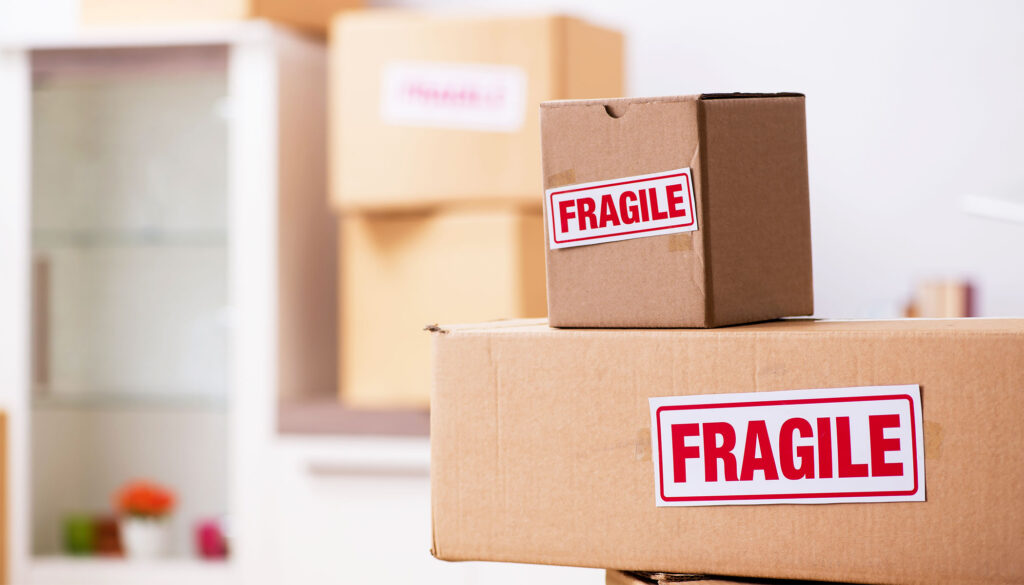When it comes to your belongings, some items are certainly more fragile than others. Fine art, glassware, and other antiques require careful packing and handling, as well as proper storage, in order to remain in pristine condition, especially if a mover is handling your items. Whether you’re packing a valuable set of delicate china or even just a few old photographs, here are some tips to keep your fragile and valuable items safe during the move.
 Prepare in advance
Prepare in advance
When preparing for a move, the first thing you should do is sit down and create a list of all your delicate, valuable, or fragile items. This inventory list will be invaluable in the rare, but oh-so-unfortunate event that anything breaks or goes missing during the move and you end up having to make an insurance claim.
In addition to creating an inventory list, it’s also important to take a few photographs of each item.
How to pack and store the most popular fragile items
Fine China
If you’re packing different kinds of fine china or dishes, start by grouping like items together – plates with plates, bowls with bowls, cups with cups, saucers with saucers, and so on. Neatly wrap each item in tissue paper, keeping them organized by type and size. Use scotch tape to secure the tissue paper, rather than packing tape, as packing tape is very strong and can easily rip right through tissue paper.
Once the pieces are wrapped with tissue paper, wrap each piece with bubble paper, covering every exposed area. You should no longer feel the china underneath the padding.
If you’re packing china plates, you can stack them, but keep in mind that if the plates are heavy, you should not stack more than 5 plates at a time. If they’re light and small like saucers or bread plates, you can stack up to 6 plates. Use your best judgment here!
Glassware
Wrap glasses individually with packing paper, plain newsprint, or bubble wrap. To ensure that wrapping stays in place, secure it with a small strip of scotch tape. Glasses and delicate stemware are best protected from damage when they’re packed in boxes that are divided into individual cells, like this one.
Everyday glassware, from all purpose drinkware to casual stemware, should be stored in a dry, dust, and pest-free environment. While unpacking, you might be tempted to crowd your cabinets with as many glasses as possible, but it’s best to let them breathe and allow for some wiggle room. This will prevent scratches, as well as any accidental breakage.
Silver
Air can cause silverware to tarnish, so it’s important that all silverware pieces – flatware, coffee sets, dishes – are wrapped completely in clean, unprinted packing or tissue paper. Loose silverware should be wrapped in sets with clear plastic, tissue, or packing paper.
If your silverware is in a chest, you still may want to consider wrapping the pieces individually and repositioning them. You can fill all empty spaces in the chest with tissue paper or clean paper towels and wrap the chest with a large blanket or bath towel for further protection.
Vintage Photographs
Prolonged exposure to direct sunlight can cause fading and loss of sheet integrity. To keep your old photographs in pristine condition during the move, it’s important to protect them from light as much as possible.
If unframed, the best way to store old photographs is in archival storage materials or a dark container, such as a Solander Box. Make sure that all materials are labeled “acid free” when looking to purchase scrapbooks, filing cabinets, or other packing and storage materials.
Fine Art
Handle artwork as little as possible. Finger oils can damage artwork by leaving smudges and oily residue. Especially when caring for prints and works on paper, you can greatly reduce the risks of creases, bends, or smudges by carrying paper by the two corners or by supporting the work from underneath, rather than pinching it.
It’s also important to remember to only lean canvases against a flat surface. However obvious, leaning the front or back of a stretched canvas against a sharp or pointed object, no matter how small, will leave a dent that could irreparably damage the piece. If you lean a work of art against anything, make sure to lean it on the wood of its stretcher bars to ensure that nothing presses against the canvas.
Label your boxes
Once you’ve successfully packed your boxes, make sure to label each one with your name, the contents, and a vertical arrow pointing upward to indicate that the box should not be loaded on its side. In addition, the words “FRAGILE” or “HANDLE WITH CARE” should be displayed prominently on at least two adjacent sides of each box.


